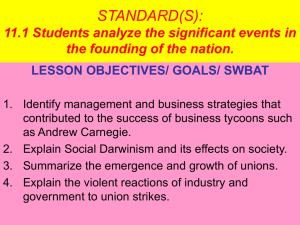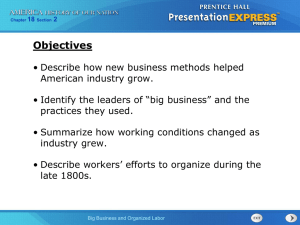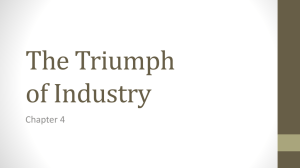CHAPTER 6: A NEW INDUSTRIAL AGE
advertisement
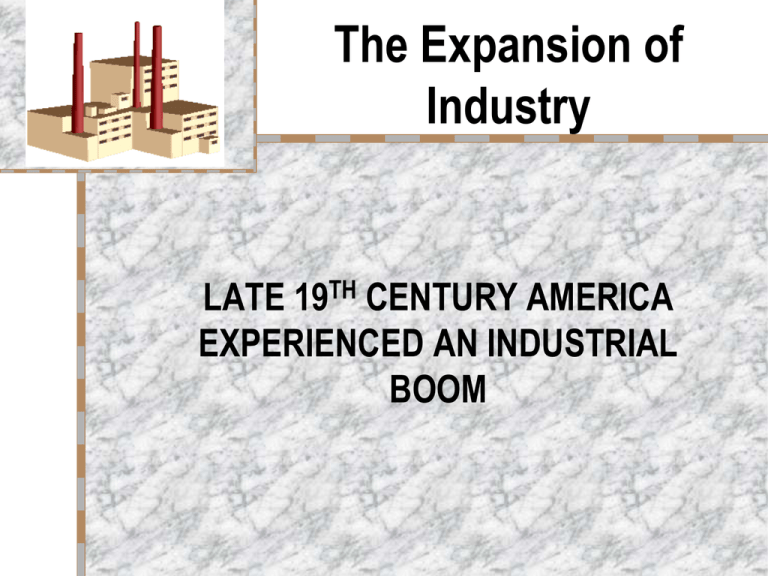
The Expansion of Industry LATE 19TH CENTURY AMERICA EXPERIENCED AN INDUSTRIAL BOOM SECTION 3: BIG BUSINESS AND LABOR Andrew Carnegie was one of the first industrial moguls He entered the steel industry in 1873 By 1899, the Carnegie Steel Company manufactured more steel than all the factories in Great Britain combined CARNEGIE BUSINESS PRACTICES Carnegie initiated many new business practices such as; Searching for ways to make better products more cheaply Accounting systems to track expenses Attracting quality people by offering them stock & benefits ANDREW CARNEGIE 1835 -1919 CARNEGIE’S VERTICAL INTEGRATION Carnegie attempted to control as much of the steel industry as possible How? Vertical integration; he bought out his suppliers (coal fields, iron mines, ore freighters, and rail lines) in order to control materials and transportation HORIZONTAL INTEGRATION Additionally, Carnegie bought up the competition through friendly and hostile takeovers This is known as Horizontal Integration; buying companies that produce similar products – in this case other steel companies MERGERS BUSINESS GROWTH & CONSOLIDATION Mergers could result in a monopoly (Trust) A monopoly is complete control over an industry An example of consolidation: In 1870, Rockefeller Standard Oil Company owned 2% of the country’s crude oil By 1880 – it controlled 90% of U.S. crude oil CHICAGO’S STANDARD OIL BUILDING IS ONE OF THE WORLD’S TALLEST SOCIAL DARWINISM DARWIN (RIGHT) LIMITED HIS FINDINGS TO THE ANIMAL WORLD SPENCER WAS THE ONE WHO COINED THE PHRASE “SURVIVAL OF THE FITTEST” The philosophy known as Social Darwinism has its origins in Darwin’s theory of evolution Darwin theorized that some individuals in a species flourish and pass their traits on while others do not Social Darwinists (like Herbert Spencer) believed riches was a sign of God’s favor, and being poor was a sign of inferiority and laziness ROBBER BARONS Alarmed at the cutthroat tactics of industrialists, critics began to call them “Robber Barons” Famous “Robber Barons” included Carnegie, Rockefeller, Vanderbilt, Stanford, and J.P. Morgan J.P MORGAN IN PHOTO AND CARTOON ROBBER BARONS WERE GENEROUS, TOO Despite being labeled as greedy barons, rich industrialists did have a generous side When very rich people give away lots of money it is called “Philanthropy” Carnegie built libraries, Rockefeller, Leland Stanford, and Cornelius Vanderbilt built schools ROCKEFELLER CHAPEL – UNIVERSITY OF CHICAGO SHERMAN ANTI-TRUST ACT In 1890, the Sherman AntiTrust Act made it illegal to form a monopoly (Trust) Prosecuting companies under the Act was not easy – a business would simply reorganize into single companies to avoid prosecution Seven of eight cases brought before the Supreme Court were thrown out (REAL TRUST) WORKERS HAD POOR CONDITIONS Workers routinely worked 6 or 7 days a week, had no vacations, no sick leave, and no compensation for injuries Injuries were common – In 1882, an average of 675 workers were killed PER WEEK on the job LABOR UNIONS EMERGE As conditions for laborers worsened, workers realized they needed to organize The first large-scale national organization of workers was the National Labor Union in 1866 The Colored National Labor Union followed CRAFT UNIONS Craft Unions were unions of workers in a skilled trade Samuel Gompers led the Cigar Makers’ International Union to join with other craft unions in 1886 Gompers became president of the American Federation of Labor (AFL) He focused on collective bargaining to improve conditions, wages and hours INDUSTRIAL UNIONISM Some unions were formed with workers within a specific industry Eugene Debs attempted this Industrial Union with the railway workers In 1894, the new union won a strike for higher wages and at its peak had 150,000 members EUGENE DEBS SOCIALISM AND THE IWW Some unionists (including Debs) turned to socialism – an economic and political system based on government control of business and property and an equal distribution of wealth among all citizens The International Workers of the World (IWW) or Wobblies, was one such socialist union PROMOTIONAL POSTER FOR THE IWW STRIKES TURN VIOLENT Several strikes turned deadly in the late 19th century as workers and owners clashed The Great Strike of 1877: Workers for the Baltimore and Ohio Railroad struck to protest wage cuts Other rail workers across the country struck in sympathy Federal troops were called in to end the strike THE HAYMARKET AFFAIR Labor leaders continued to push for change – and on May 4, 1886 3,000 people gathered at Chicago’s Haymarket Square to protest police treatment of striking workers A bomb exploded near the police line – killing 7 cops and several workers Radicals were rounded up and executed for the crime THE HOMESTEAD STRIKE Even Andrew Carnegie could not escape a workers strike Conditions and wages were not satisfactory in his Steel plant in Pennsylvania and workers struck in 1892 Carnegie hired Pinkerton Detectives to guard the plant and allow scabs to work Detectives and strikers clashed – 3 detectives and 9 strikers died The National guard restored order – workers returned to work THE PULLMAN STRIKE After the Pullman Company laid off thousands of workers and cut wages, the workers went on strike in the spring of 1894 Eugene Debs (American Railroad Union) tried to settle dispute which turned violent Pullman hired scabs and fired the strikers – Federal troops were brought in Debs was jailed WOMEN ORGANIZE Although women were barred from most unions, they did organize behind powerful leaders such as Mary Harris Jones She organized the United Mine Workers of America Mine workers gave her the nickname, “Mother Jones” Pauline Newman organized the International Ladies Garment Workers Union at the age of 16 EMPLOYERS FIGHT UNIONS The more powerful the unions became, the more employers came to fear them Employers often forbade union meetings and refused to recognize unions Employers forced new workers to sign “Yellow Dog Contracts,” swearing that they would never join a union Despite those efforts, the AFL had over 2 million members by 1914 Partner Questions, Chapter 6, Section 3 What appears to have been the chief goal of big business during the late 1800s, and why did the government begin making efforts to prevent big business from achieving this goal? Explain the theory of social Darwinism.
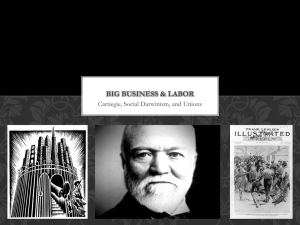

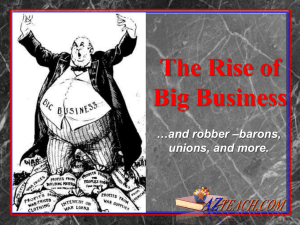

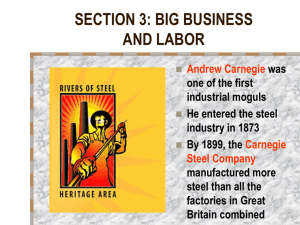

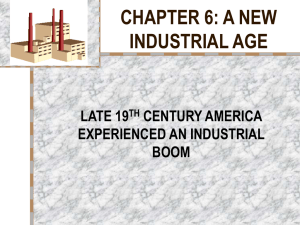
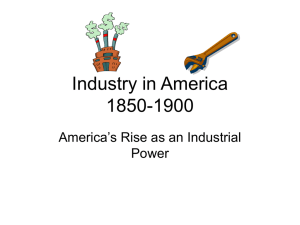
![men_who_built_america[1]](http://s2.studylib.net/store/data/005219845_1-7979604da89ac700f7913bb56611cc41-300x300.png)
